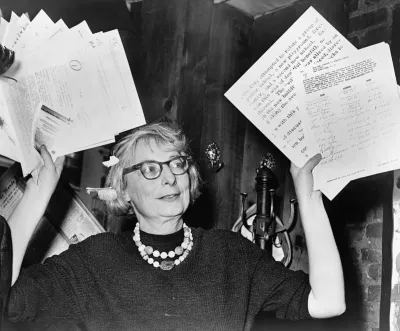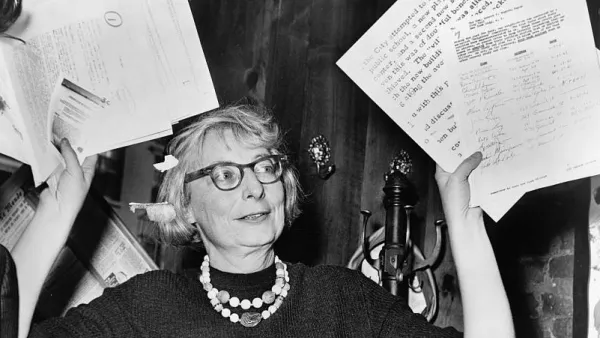Coinciding with the 101st anniversary of Jane Jacobs's birth, a documentary film showing in select theaters around the country recounts the history between Jane Jacobs and Robert Moses, and the ideas that forced their struggle.

For a historic figure that looms so large in the consciousness of planners and urbanists all over the continent, Jane Jacobs never had a documentary made about her, until now. "Jane Jacobs: Battle for the City" has been playing in select theaters since April 21, including here in Los Angeles, where its run continues until tonight at the Nuart Theatre at Santa Monica and Sawtelle.
The appeal of such a movie is obvious to many planners and urbanists, who have long viewed Jacobs with admiration and a degree of ambivalence. On one hand, there's "Saint Jane," who successfully overcame the powers that be in the name of neighborhood protection on several occasions. On the other hand, there's a legacy of opposition that has turned the powers that be over to obstructionists and litigants, and away from experts.
Enter "Citizen Jane," directed by Matt Tyrnauer and produced by Robert Hammond, whose name should be familiar to fans of the High Line. The release of this documentary, with a discussion of 20th century housing and transportation policies that resonate to this day, requires more ambivalence and a careful examination of our assumptions. The "battle" of the documentary's title should be familiar to anyone with even a passing interest in 20th century city planning: Two opposing movements for the future of New York, as embodied in the film by Jane Jacobs and Robert Moses, fought to decide the big questions of who decides the form of a city, how it functions, and who lives there.
The documentary describes Jacobs's project as a "theory of opposition." At one point in the film, Jacobs is described as opposing "city planners infected by the disease of modernism." Historic recordings of Jacobs speaking on radio are supplemented with experts and historians setting the scene of some of Jacobs's most daring and successful exploits. Familiar authorities, like James Howard Kunstler, Paul Goldberger, and Anthony Flint, lend sufficient gravitas to the accomplishments and causes of Jacobs, even if they don't reveal more than many in the audience already know. Previously unreleased footage of an interview with Jacobs, shot for a failed documentary project in the 1970s, is the film's most exciting addition to the Jacobs canon.
On the other side of the conflict, Moses is a proxy for "city planner"—in this case white men in three-piece suits, moving around the pieces on gigantic models of New York while chain smoking cigars. Moses himself is a character so crudely offensive that it won't be hard for most viewers to pick sides in this battle. Many planners and urbanists who enjoy places like Washington Square Park and Greenwich Village probably already have a certain distaste for Robert Moses's agenda of urban renewal, but watching his actions on screen, speaking in condescending and patriarchal terms to dismiss the concerns of New Yorkers, Moses becomes a villain of a much more thorough sort. Repeated, protracted historic footage of "slum clearance"—with bulldozers and workers tearing and sledgehammering building after building—takes a wrecking ball to the possibility that Moses might ever have accomplished something worthwhile in his career.
The concern then, for anyone watching the process of city making in 2017, is who will self-identify with Jane Jacobs, the citizen hero, and who gets lumped in with the evils of city planning and urban renewal in the 20th century.
Unfortunately, the documentary doesn’t place the historic conflict in context of the current conflicts in New York City, or any other American city. Instead, the filmmakers chose China and the Global South as the location to set the contemporary battle between modernism and the "organized complexity" favored by Jacobs. In China, the process of urbanization has outdone Moses, according to the film's framing. There, the "tower in a park" model of housing development, first presented by Le Corbusier then adopted at scale by Moses and planners in cities like Chicago and St. Louis, has been injected with steroids. Isolation, environmental degradation, and the inevitable failure of Le Corbusier's housing legacy are sure to follow.
Unaddressed, however, are the less tidy dichotomies of contemporary political battle in cities like New York, Los Angeles, or Seattle. On one hand, we have housing and transit advocates, fighting to make room for more people in the city, but potentially susceptible to the same failings of clairvoyance as previous generations of planners. On the other hand: an opposition armed with less eloquent ideas than Jacobs about neighborhood character and perhaps more concern about property values than Jacobs could have imagined.
In a question and answer session after a recent screening, I asked the director, Matt Tyrnauer, about why the film avoided these subjects, and he said couldn't compare the contemporary conflicts between planners and "NIMBYs" to the causes of Jane Jacobs without becoming too specific. In the hopes of finding a more generally applicable takeaway for existing cities, Tyrnauer identified a message about incrementalism: "You don't want to clear cut the forest. Sometimes you have to prune a little or take down some trees for the good of the forest."
As for his take on Jacobs, Trynauer said she's often mischaracterized as the "Queen of NIMBYs," but that she wasn't advocating for stasis: "What she's telling us is cities are ecologies, and ecologies are always changing. We have to react to that change, and we have to do it in sensible way."
The battle lines, it seems, have changed too.

National Parks Layoffs Will Cause Communities to Lose Billions
Thousands of essential park workers were laid off this week, just before the busy spring break season.

Retro-silient?: America’s First “Eco-burb,” The Woodlands Turns 50
A master-planned community north of Houston offers lessons on green infrastructure and resilient design, but falls short of its founder’s lofty affordability and walkability goals.

Delivering for America Plan Will Downgrade Mail Service in at Least 49.5 Percent of Zip Codes
Republican and Democrat lawmakers criticize the plan for its disproportionate negative impact on rural communities.

Test News Post 1
This is a summary

Test News Headline 46
Test for the image on the front page.

Balancing Bombs and Butterflies: How the National Guard Protects a Rare Species
The National Guard at Fort Indiantown Gap uses GIS technology and land management strategies to balance military training with conservation efforts, ensuring the survival of the rare eastern regal fritillary butterfly.
Urban Design for Planners 1: Software Tools
This six-course series explores essential urban design concepts using open source software and equips planners with the tools they need to participate fully in the urban design process.
Planning for Universal Design
Learn the tools for implementing Universal Design in planning regulations.
EMC Planning Group, Inc.
Planetizen
Planetizen
Mpact (formerly Rail~Volution)
Great Falls Development Authority, Inc.
HUDs Office of Policy Development and Research
NYU Wagner Graduate School of Public Service




























